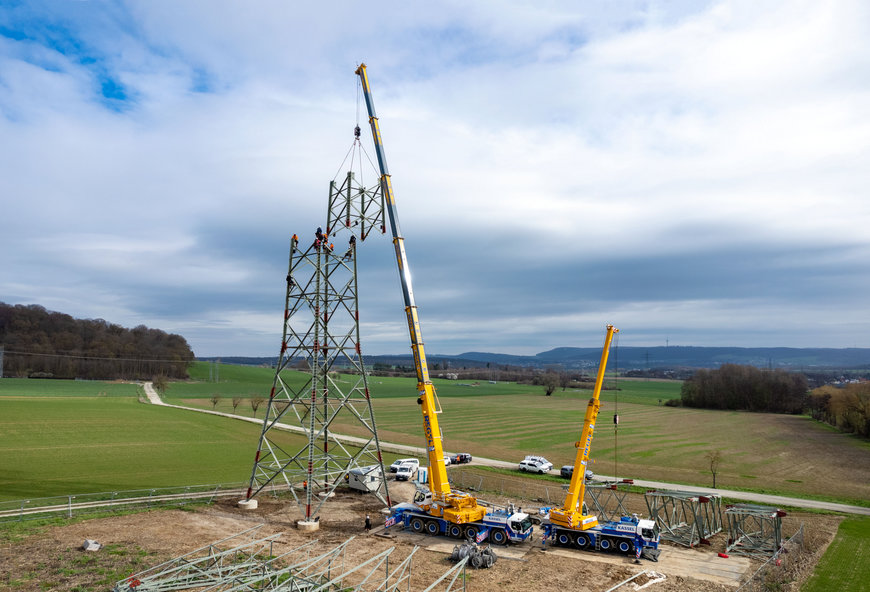Liebherr power for the energy transition
The transport of wind power from the coastal regions to the south of Germany is an essential point for the success of the energy transition and the transformation towards renewable energies.

Energy transition: Regel has erected well over 100 electricity pylons with Liebherr mobile cranes.
- Liebherr mobile cranes build on important route for wind power
- LTM 1230-5.1 erects overhead line pylons in daily cycles with LTM 1070-4.2
- Albert Regel GmbH has already erected over 100 electricity pylons
In order to expand these capacities, new, high-performance power lines are indispensable. The largest project currently underway, an extra-high voltage line through Lower Saxony and Hesse, is being realised with Liebherr mobile cranes from Albert Regel GmbH, among others.
The energy transition project with the somewhat unadorned title "Wahle-Mecklar" has it all: 555 mighty electricity pylons have to be erected over a length of 230 kilometres. Only a very small part of the route will be bridged with underground cables. The new power line, which runs through the federal states of Lower Saxony and Hesse, is scheduled for completion in 2024 after a total of four years of construction. Several Liebherr mobile cranes are being used to erect the pylons, which are up to 90 metres high. Albert Regel GmbH, headquartered in Baunatal near Kassel in Hesse, regularly sends equipment from its modern fleet to the pipeline construction site.

All-terrain assistant: While the large Liebherr mobile crane lifts the lattice mast construction of the overhead line, here the LTM 1070-4.2 prepares the next component for assembly.
Extremely long telescopic boom - usually no jib required
"When it comes to mast construction, the crane of choice here is clearly our LTM 1230-5.1," reports Daniel Stawizki, dispatcher at Regel. "With its 75-metre telescopic boom, the mobile crane can manage almost all of these jobs without the aid of a jib. We only use a 32-metre fixed jib on the crane for the largest of the up to 90-metre high overhead line pylons. A few times we have also sent out our 300-tonne LTM for this."
Most of the time, Regel's LTM 1070-4.2 flanks the crane work on the future power line. It handles the individual lattice tower elements on the ground and lends a hand when the components have to be brought into a vertical position for assembly together with the large mobile crane. This compact, modern 70-tonne mobile crane can carry most of its ballast on the road. Moreover, due to its active and speed- dependent rear-axle steering, it is virtually predestined to easily reach the work sites in the terrain and to be ready to pull within a very short time.
For three years now, Regel's cranes have been moving out to the construction sites of the grid operator Tennet in phases. "We have definitely already erected well over a hundred of the electricity pylons," reports Stawizki. "If everything works out, the completed lattice tower will be up within a day in the evening." The company has also already had an LTM 1200-5.1 in action together with an LTM 1090-4.2 as a team on the construction sites along the route.
At the company's headquarters in Baunatal, Regel operates around 40 mobile cranes together with a depot near Fulda. With the exception of five machines, they all come from the Liebherr factory in Ehingen. In addition to crane work, Albert Regel GmbH also offers heavy transport as well as machine and industrial relocations.
www.liebherr.com

